Forces topic 5
1/72
Earn XP
Description and Tags
Name | Mastery | Learn | Test | Matching | Spaced |
|---|
No study sessions yet.
73 Terms
whats force a quantity of & whats it, examples of vector (5) & scalar quantities (5), vectors r represented by…
force is a vector quantity (magnitude + direction)
vector quantities → force, velocity, displacement, acceleration, momentum
scalar quantities (magnitude, no direction) → speed, distance, mass, temp, time
vectors r rep by an arrow - length of arrow shows magnitude & direction of arrow shows direction of quantity
whats force, all forces r…, what r contact forces & examples (4), what r non-contact forces & examples (3),
force → push/ pull on object caused by it interacting w something
all forces r either contact/ non-contact forces
when 2 objects have to be touching for force to act → contact force (friction, air resistance, tension in ropes, normal contact force
If objects dont need to touch for force to act → non-contact force (magnetic force, gravitational force, electrostatic force)
when 2 forces interact… & whats interaction pair, the sun & earth r…(example), chair exerts… (example),
When 2 forces interact there is a force produced on both objects. Interaction pair → pair of forces that r equal & opposite & act on 2 interacting objects (basically newtons 3rd law)
sun & earth r attracted to each other by gravitational force. This is non-contact force. An equal but opposite force of attraction is felt by both the sun & earth
chair exerts force on ground, whilst the ground pushes back at chair w same force (normal contact force). Equal but opposite forces r felt by both chair & ground

gravity attracts… & anything near…, 2 important factors of gravity,
gravity attracts all masses, but u only notice it when one of masses is really really big (planet). Anything near a planet/star is attracted to it very strongly
gravity has 2 important factors:
on surface of planet, it makes all things fall towards the ground
it gives everything a weight
whats mass & its value.., whats weight & close to earth.., gravitational field strength varies… & its stronger…,
mass → amount of ‘stuff’ in object, will have same value anywhere in universe
weight → force acting on object due to gravity (pull of gravitational force on object). Close to earth, this force is caused by gravitational field around the earth
gravitational field strength varies w location. Its stronger the closer u r to mass causing field & stronger for larger masses
Weight of an objects depends on… & this means, example, weights measured in & whats centre of mass & for uniform object…, whats weight measured in, mass is… measured in… w a…
weight of an object depends on strength of gravitational field at location of object. Means that the weight of an object changes w its location
example → object has same mass whether its on earth/moon - but weight will be diff. A 1kg mass will weight less on moon (1.6N) than it does on earth (9.8N) because gravitational field strength on surface of moon is less
weight is force measured in newtons. Can think of force as acting from single point on object → centre of mass (point u assume whole mass is concentrated). For uniform object (one thats same density throughout & is regular shape), this will be at centre of object
weight is measured using a calibrated spring balance (or newtonmeter)
Mass is not a force, measures in kilograms w mass balance
equation for weight, mass & weight r.., gravitational field strength for earth & moon
weight (N) = Mass (kg) x gravitational field strength (N/kg)
mass & weight r directly proportional
earth g= 9.8N/Kg, Moon g=1.6N/kg
need to be able to describe all forces… & i.e., example, can be shown…, size of arrows show… & directions…
need to be able to describe all forces acting on isolated object/ a system - i.e. every force acting on object/ system but none of forces the object/ system exerts on rest of world
example → a skydiver’s weight acts on him pulling him towards ground & drag (air resistance) also acts on him, in opposite direction to his motion
can be shown using free body diagram
sizes of arrows show relative magnitudes of forces & directions show the directions of forces acting on object
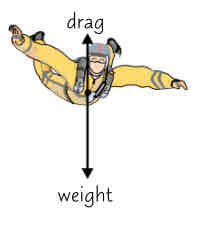
in most real situations there r at least…, if have number of forces acting on single point…, this single force is.., how is overall effect of forces found,
in most real situations there r at least 2 forces acting on an object along any direction
if have no. of forces acting at single point, u can replace them w single force (as long as single force has same effect as all og forces tgther)
this single force → resultant force
if forces all act along same line (parallel), the overall effect is found by adding those going in same direction & subtracting any going in opposite direction
when is energy transferred & work is done on object, when must a force be applied, thing applying the force needs…, the force does ‘work’ to…
when a force moves an object through a distance, energy is transferred & work is done on the object
to make something move (/ keep it moving if there r frictional forces), a force must be applied
the thing applying the force needs a source of energy (like fuel/ food)
the force does ‘work’ to move object & energy is transferred from 1 store to another
whether energy is transferred ‘usefully’/ ‘wasted can still say…, example,
whether energy is transferred ‘usefully’ (lifting a load) or is ‘wasted’ u can still say that ‘work is done’ (energy transferred is same)
example → when push smthing along rough surface (carpet) u r doing work against frictional forces. Energy is being transferred to kinetic energy store of object because it starts moving but some is also being transferred to thermal energy stores due to friction. This causes the overall temp of object to increase (like rubbing hands tgther ti warm them up
equation for work done, 1J is equal to _ Nm
W = Fs
W → work done (J)
F → Force (N)
s → distance (moved along line of action of the force) (m)
1 joule of work is done when force of 1 newton causes an object to move distance of 1 metre. 1J =1 N⋅m 1Nm (newton metre)
whens an object at equilibrium, whats it mean on scale drawing, how to calculate missing force on scale drawing
if all of forces acting on object combine to give resultant force of 0 the object is at equilibrium
on scale drawing → means tip of the last force u draw should end where the tail of the first force u drew begins
might be given forces acting on object & told to find missing force, given the object is in equilibrium. To do this draw out forces u do know (to scale & tip-to-tale), join the end of last force to start of first force. The line is the missing force so u can measure its size & direction
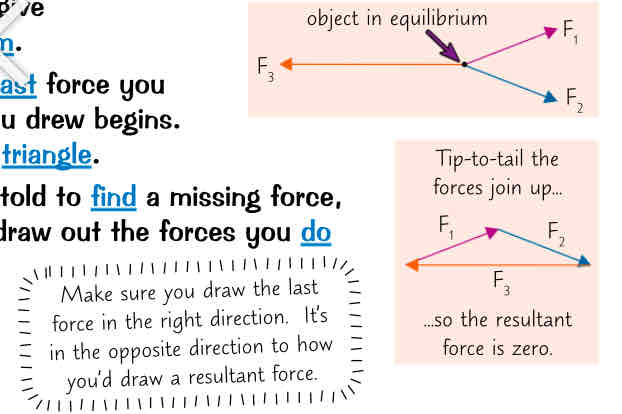
how to deal w force that don’t act horizontally/ vertically, acting tgther these components…, u can resolve a force by drawing it on…
not all forces act horizontally/ vertically so to make these easier to deal w they can be split into 2 components at right angles to each other (usually horizontally & vertically)
acting tgther these components have same effect as the single force
can resolve a force (split into components) by drawing it on scale grid. draw the force to scale & then add the horizontal & vertical components along the grid lines. Then can just measure them
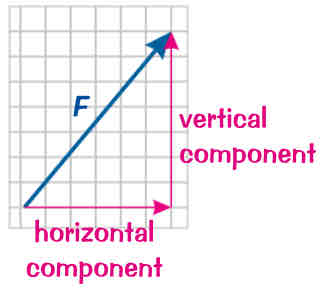
what causes object to stretch, compress or bend, to do this need more than…, when has an object been elastically deformed…, whats elastic objects
when apply a force to an object u may cause it to stretch, compress or bend
to do this u need more than 1 force acting on the object (otherwise object would simply move in direction of applied force, instead of changing shape)
an object has been elastically deformed if it can go back to its og shape & length after force has been removed
object thats r elastically deformed → elastic objects
whens a object inelastically deformed, work is done when… & when all this energy transferred to elastic potential energy store
an object has been inelastically deformed if it doesnt return to its og shape & length after force has been removed
work is done when force stretches/ compresses an object & causes energy to be transferred to elastic potential energy store of object. If its elastically deformed all this energy is transferred to objects elastic potential energy store
when does spring stretch, extension of stretched spring is…, equation for force.., spring constant depends on…, this equation also works for..
if spring is supported at top & then a weight is attached to bottom it stretches
extension of stretched spring (other elastic objects) is directly proportional to the load/ force applied - F∝e
F=ke, F→force (N), k→ spring constant (N/m), e→ extension (m)
spring constant depends on material that u r stretching - a stiffer spring has a greater spring constant
this equation also works for compression (where e is just the diff between the natural & compressed lengths - the compression)
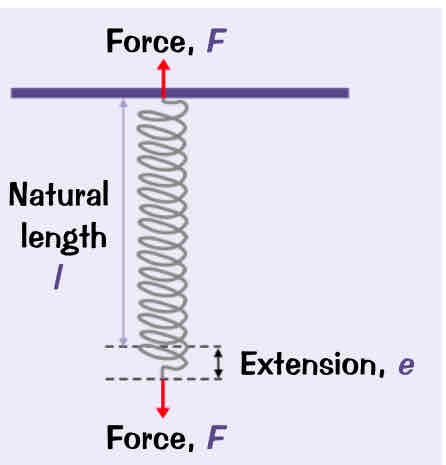
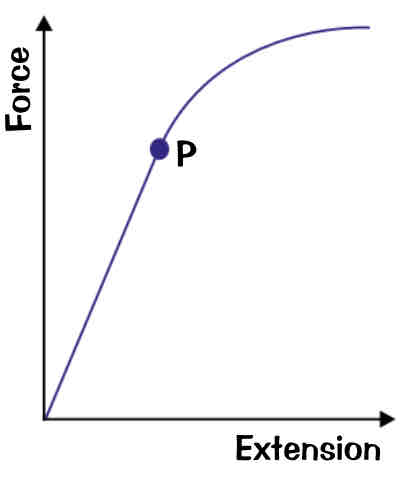
theres a limit to amount of force can apply to an object for extension to…, whats does graph show, whats limit of proportionality & wheres it shown on graph, whats do graphs w axes other way round show,
theres a limit to amount of force u can apply to an object for extension to keep on increasing proportionally
graph shows force against extension for an elastic object
theres maximum force above which graph curves showing that extension is no longer proportional to force. Known as the limit of proportionality & is shown on graph at point marked P
graphs w axes other way round (extension-force graphs), graph still starts w straight part but starts to curve upwards once u go past limit of proportionality instead of downwards
how to do pilot experiment first to check masses r good size on investigation on between force & link
using identical spring to one u’ll be testing, load it w masses one at a time up to a total of five. Measure the extension each time u add another mass
work out increase in extension of spring for each of ur masses. If any of them cause bigger increase then the previous masses, u’ve gone past springs limit of proportionality. If this happens, u’ll need to use smaller masses, or else u won’t get enough measurements for ur graph
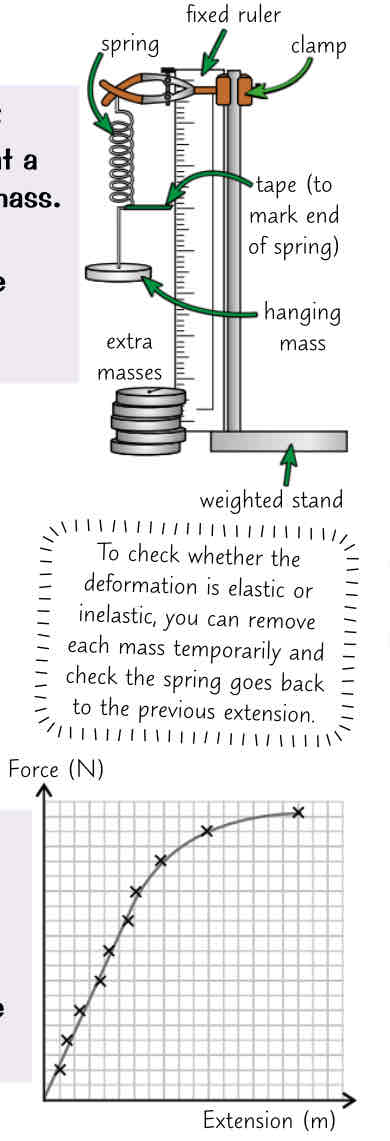
investigation on link between force & extension (4 steps, 2 points for force-extension graph)
measure natural length of spring (when no load is applied) w a millimetre ruler clamped to stand. Make sure u take reading at eye level & add a marker (thin strip of tape) to bottom of the spring to make reading more accurate
add mass to spring & allow it to come to rest. Record the mass & measure the new length of spring. The extension is the change in length
repeat this process until u have enough measurements (no fewer than 6)
plot a force-extension graph of ur results. It will only start to curve if u exceed limit of proportionality but dont worry if urs doesnt (as long as u’ve got straight line bit)
when line of best fit is a straight line it means theres linear relationship between force & extension (they’re directly proportional). F=ke so the gradient of straight line is equal to k, the spring constant
when line begins to bend, the relationship is now non-linear between force & extension - spring stretches more for each unit increase in force
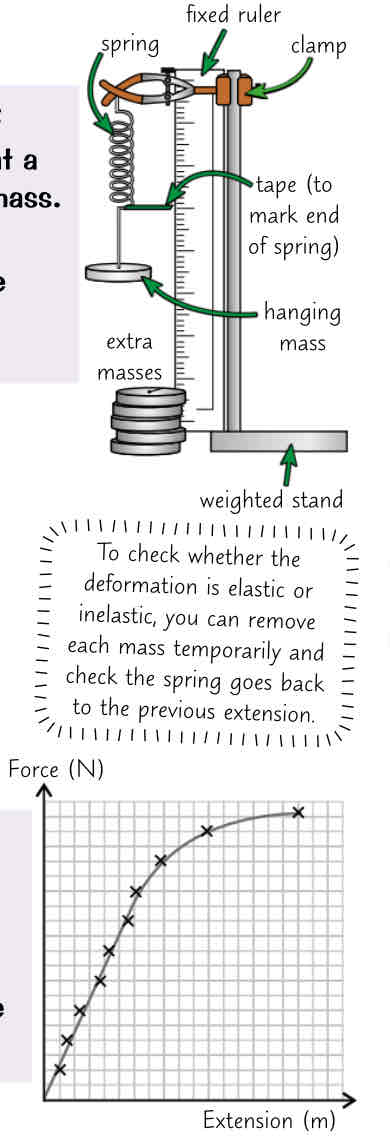
as long as spring is not stretched past…, whats the equation for elastic potential energy, for elastic deformation it can be used for… & its also energy transferred to spring…
as long as spring is not stretched past its limit of proportionality the work done in stretching (/ compressing) a spring can be found using the equation
E_e = ½ ke²
E_e → elastic potential energy (J)
k → spring constant (N/m)
e → extension (m)
for elastic deformation, formula can be used to calculate the energy stored in a springs elastic potential energy store. Its also the energy transferred to the spring as its deformed (/ transferred by the spring as it returns to its og shape)
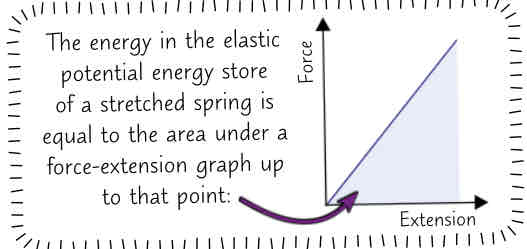
force/several forces cause… & whats moment, whats equation for moment of force, force on spanner causes…, to get maximum moment…
force/ several forces can cause object to rotate. The turning effect of a force → moment. Size of moment of the force is given by equation
M=Fd
M → moment of force (Nm)
F → force (N)
d → Distance (m) - the perpendicular distance from the pivot to line of action of force
force on spanner causes turning effect/ moment on nut (acts as pivot). A larger force/ longer distance (spanner) would mean a larger moment
to get maximum moment (/ turning effect) u need to push at right angles (perpendicular) to spanner. Pushing at any other angle means smaller distance & so smaller moment
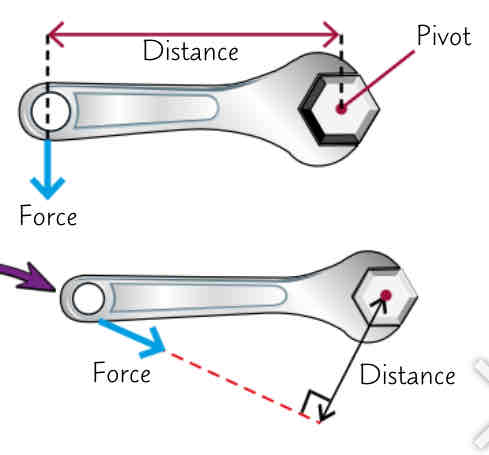
if total anticlockwise moment equals total clockwise moment…, how to find missing force/ distance using moment of force equation (2 steps)
If total anticlockwise moment equals total clockwise moment about a pivot, the object is balanced & wont turn. Can use equation to find a missing force/distance in these situations
for girder to balance the total anticlockwise moment should equal the total clockwise moment
stick in the numbers u know & rearrange for T

levers increase distance…, this means…
levers increase distance from pivot at which force is applied. Since M=Fd this means less force is needed to get same moment
this means levers make it easier to do work (lift a load or turn a nut)
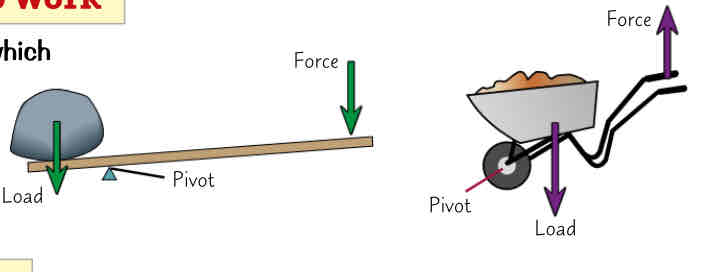
whats gears, their teeth interlock.., they r used to transmit…, diff sized gears can be used… & a force transmitted to larger gear…, the larger gear will turn…
gears → circular discs w ‘teeth’ around their edges
their teeth interlock so that turning 1 causes another to turn in opposite direction
they r used to transmit the rotational effect of force from 1 place to another
different sized gears can be used to change the moment of force. A force transmitted to a larger gear will cause a bigger moment, as the distance to the pivot is greater
the larger gear will turn slower than the smaller gear
whats fluids, as these particles move around.., particles r light but… & whats pressure, pressure of fluid means..
fluids → substances that can ‘flow’ because their particles r able to move around
as these particles move around, they collide w surfaces & other particles
particles r light, but they still have a mass & exert a force on object they collide w. Pressure → force per unit area so this means the particles exert a pressure
the pressure of a fluid means a force is exerted normal (at right angles) to any surface in contact with fluid
How can u calculate pressure at the surface of a fluid using equation
P=F/A
P → pressure in pascals (Pa)
F → force normal to a surface (N)
A → area of that surface (m²)
whats density a measure of & i.e. & for given liquid.. & density of gas.., more dense given liquid is… & this means.., as depth of liquid increases… & the weight of these particles…
Density is measure of the ‘compactness’ of a substance, i.e. how close tgther the particles in a substance r. For a given liquid, the density is uniform (same everywhere) & it doesnt vary w shape/ size. Density of gas can vary
The more dense given liquid is the more particles it has in certain space. This means there r more particles that r able to collide so the pressure is higher
As the depth of the liquid increases the number of particles above that point increases. The weight of these particles adds to the pressure felt at that point, so liquid pressure increases w depth
how can u calculate pressure at certain depth due to the column of liquid above using equation
p=hpg
P → pressure (Pa)
h → height of the column of liquid (the depth) in m
p (2nd)→ density of liquid (kg/m³) (symbol is greek letter ‘rho’)
g → gravitational field strength (N/kg)
(can write answer in standard form)

when an object is submerged.., pressure increases w depth so…, this causes.., whats equal to weight of fluid… & e.g…
when an object is submerged in fluid (either partially/ completely) the pressure of fluid exerts a force on it from every direction
Pressure increases w depth so the force exerted on the bottom of the object is larger than the force acting on the top of the object
This causes a resultant force upwards known as upthrust
The upthrust is equal to weight of fluid that has been displaced (pushed out of the way) by the object. E.g. the upthrust on a pineapple in water is equal to weight of a pineapple-shaped volume of water
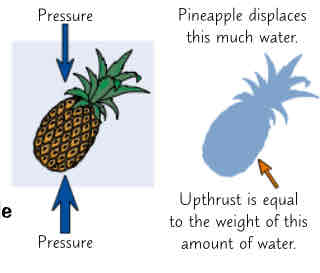
when does object float, when does it sink, what depends on density, an object thats less dense than fluid… & this means.., at this point…,
if upthrust on an object is equal to objects weight then the forces balance & object floats
If an objects weight is more than the upthrust, the object sinks
whether or not an object will float depends on its density
an object thats less dense than fluid its placed in weighs less than equivalent volume of fluid. Means it displaces a volume of fluid that is equal to its weight before its completely submerged
At this point the objects weight is equal to the upthrust so object floats

an object thats denser than fluid… & this means.., example
an object thats denser than fluid its placed in is unable to displace enough fluid to equal its weight. This means that its weight is always larger than the upthrust so it sinks
example → submarines make use of upthrust. To sink, large tanks r filled w water to increase the weight of submarine so that it is more than upthrust. To rise to the surface the tanks r filled w compressed air to reduce the weight so that its less than the upthrust

whats atmosphere & its thin compared to.., atmospheric pressure is created…, as altitude increases…, this is because…, there r also fewer… & this means…,
Atmosphere → layer of air that surrounds earth. Its thin compared to size of earth
Atmospheric pressure is created on surface by air molecules colliding w surface
as the altitude (height above earth) increases, atmospheric pressure decreases
This is because as altitude increases, the atmosphere gets less dense, so there r fewer air molecules that r able to collide w the surface
There r also fewer air molecules above a surface as the height increases. This means that the weight of air above it, which contributes to atmospheric pressure, decreases w altitude
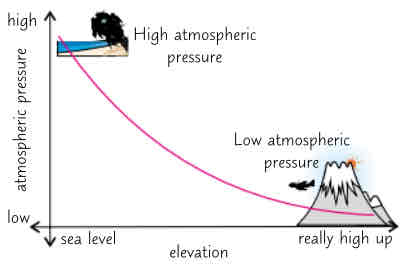
whats distance & what quantity is it, what quantity is displacement & it measures.. & e.g.. & direction could… & e.g.., example
distance → how far an object has moved. Its a scalar quantity so it doesn’t involve direction
Displacement is vector quantity. It measures distance & direction in a straight line from an objects starting point to its finishing point - e.g. the plane flew 5 metres north. The direction could be relative to a point, e.g. towards the school or bearing (3 digit angle from north)
if u walk 5m north then 5m south ur displacement is 0m but the distance travelled is 10m
what quantity is Speed/ velocity & why, this means… & this happens when… & an object moving in circle… & e.g..,
speed (scalar) is how fast u’re going w no regard to direction. Velocity is speed in given direction
means can have objects travelling at constant speed w changing velocity. This happens when the object is changing direction whilst staying at same speed. An object moving in a circle at constant speed has a constantly changing velocity as direction is always changing (e.g. car going around a roundabout)
Whats equation to calculate objects speed from measurements, objects rarely travel at…, if want to measure speed of object moving w constant speed…
s=vt
distance traveller (m) = speed (m/s) x time (s)
objects rarely travel at constant speed
if want to measure speed of an object thats moving w constant speed, should time how long it takes object to travel at certain distance (using ruler & stopwatch)
whats typical speed of person walking, running, cycling, car, train, plane
person walking - 1.5m/s
person running - 3m/s
person cycling - 6m/s
car - 25m/s
train - 30m/s
plane - 250m/s
whats effects speed at which person can walk, ryn, cycle, the speed of sound…, what affects wind speed
speed at which a person can walk, run/ cycle depends on their fitness, age, distance travelled, terrain as well as many other factors
(not only speed of objects varies). speed of sound (330 m/s in air) changes depending on what sound waves r travelling through & speed of wind is affected by many factors
Wind speed can be affected by things like temp, atmospheric pressure & if there r large buildings/ structures nearby (e.g. forests reduce speed of air travelling through them)
whats acceleration, whats equation for average acceleration of an object, whats deceleration
acceleration → change in velocity in certain amount of time
find average acceleration:
a=△v/t
a → acceleration (m/s²)
△v → change in velocity (m/s)
t → time (s)
deceleration is just negative acceleration (if something slows down, the change in velocity is negative)
How do you estimate accelerations? (4 steps)
give a sensible speed for the car to be travelling at
estimate how long it would take for car to stop
put these numbers into acceleration equation
the question asked for deceleration so u can lose the minus sign (which shows car is slowing down)

whats constant acceleration sometimes called, acceleration due to gravity… & its roughly equal to…, whats equation for uniform acceleration,
constant acceleration is sometimes called uniform acceleration
Acceleration due to gravity (g) is uniform for objects in free fall. Its ~ 9.8m/s² near earths surface & has same value as gravitational field strength
v²-u²=2as
v² → final velocity (m/s)
u² → initial velocity (m/s)
a → acceleration (m/s²)
s → distance (m)

if object moves in straight line.., why does gradient = speed, what r flat sections, straight uphill sections mean, curves rep.., steeping curve means, levelling off curve means, if object is changing speed…,
if an object moves in straight line, its distance travelled can be plotted on distance-time graph
gradient = speed (steeper graph the faster its going) because speed= distance/time = (change in y-axis) / (change in x-axis)
flat sections r where is stationary
straight uphill sections mean its travelling at steady speed
curves rep acceleration/ deceleration
steeping curve means its speeding up (increasing gradient)
levelling off curve means its slowing down
if object is changing speed (accelerating) u can find its speed at point by finding gradient of tangent to curve at that point
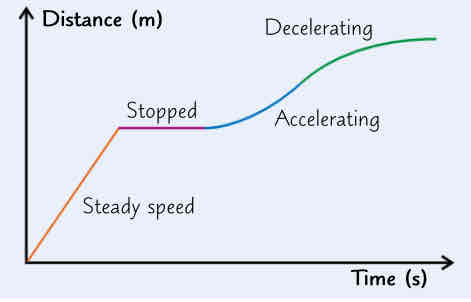
how objects velocity changes as it travels can…, y does gradient = acceleration, flat sections rep.., steeper the graph…, uphill sections r, downhill sections r, curve means, area under section of graphs is, if section under graphs is irregular..
how an objects velocity changes as it travels can br plotted on velocity-time graph
gradient = acceleration since acceleration is change in velocity/time
Flat sections rep travelling at steady speed
the steeper the graph the greater the acceleration/ deceleration
uphill sections (/) r acceleration
downhill sections (\) r deceleration
a curve means changing acceleration
area under any section of graph( or all of it) is equal to distance travelled in that time interval
if section under graph is irregular its easier to find the area by counting the squares under line & multiplying number by the value of 1 square
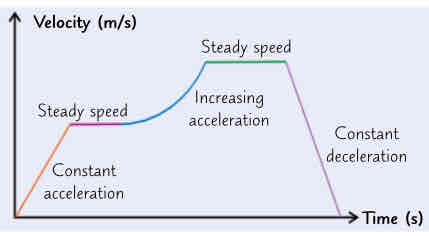
(velocity-time graph) calculate acceleration of _ over given time, how far does _ travel in given time,
this is just the gradient of the line
split the area into a triangle & a rectangle then add tgther their areas. Or find value of 1 square, count the total number of squares under the line, and multiply these 2 values tgther

if object has no force propelling it along…, what direction does friction always move in, to travel at steady speed…, u get friction…
if object has no force propelling it along it will always slow down & stop because of friction (unless u’re in space wheres theres nothing to rub against)
friction always acts in opposite direction to movement
to travel at steady speed, the driving force needs to balance frictional forces
u get friction between 2 surfaces in contact or when an object passes through a fluid (drag)
whats drag & type of it, most important factor in reducing drag… & this is where object… & parachutes work…, what always increase w speed & car has much more friction… & at 70mph the engine…
drag → resistance u get in fluid (gas/liquid). Air resistance is a type of drag
most important factor in reducing drag is keeping shape of object streamlined. This is where object is designed to allow fluid to flow easily across it, reducing drag. Parachutes work in opposite way - want as much drag as they can get
Frictional forces from fluids always increase w speed. A car has much more friction to work against when travelling at 70mph compared to 30mph. At 70mph the engine has to work much harder just to maintain a steady speed
when falling object first sets off…, as speed increases.., this gradually reduces the acceleration…, It will have reached…
when a falling object first sets off, the force of gravity is much more than the frictional force slowing it down, so it accelerated.
As speed increases the friction builds up.
this gradually reduces the acceleration until eventually the frictional force is equal to the accelerating force (so resultant force is 0).
It will have reached its maximum speed/ terminal velocity & will fall at a steady speed
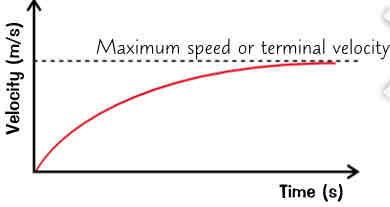
the accelerating force acting on all falling objects…, This means on the moon, on earth air resistance causes… & frictional force depends on…, whats the most important example
The accelerating force acting on all falling objects is gravity & it would make them all fall at the same rate if it wasnt fir air resistance.
This means that on moon where theres ni air hamsters & feathers dropped simultaneously will hit the ground tgther.
However, on earth air resistance causes things to fall at diff speeds & the terminal velocity of any object is determined by its drag in comparison to its weight. The frictional force depends on its shape & area
Most important example → human skydiver. Without his parachute open he has quite small area & force of ‘W=mg’ pulling him down. He reaches a terminal velocity of about 120mph. But w the parachute open theres much more air resistance (at any given speed) & still only the same force ‘W=mg’ pulling him down. This means his terminal velocity comes down to about 15mph, which is a safe speed to hit ground at
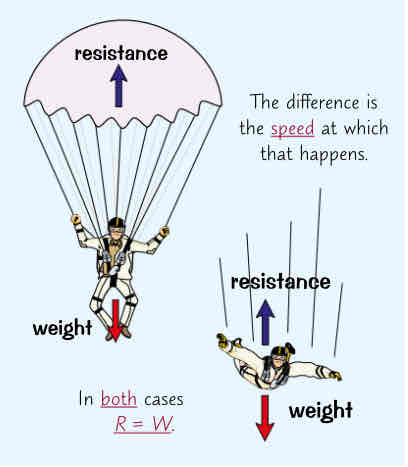
whats newtons first law, a non-zero force will always, what 5 forms of acceleration r there, on free body diagram..
Newtons first law → If the resultant force on a stationary object is 0, the object will remain stationary. If the resultant force on a moving object is 0, it’ll just carry on moving at the same velocity (same speed & direction)
A non-zero resultant force will always produce acceleration (or deceleration) in direction of force
This ‘acceleration’ can take 5 diff forms → starting, stopping, speeding up, slowing down, changing direction
on a free body diagram, the arrows will be unequal
the larger the resultant force…, acceleration is inversely proportional to…, formula describing Newton’s second law,
the larger the resultant force on an object the more the object accelerates - force & acceleration r directly proportional
acceleration is inversely proportional to mass of the object - so an object w a larger mass will accelerate less than 1 w smaller mass (for a fixed resultant force)
F=ma
F → resultant force (N)
m → mass (kg)
a → acceleration (m/s²)

how to estimate resultant force on a car as it accelerates from rest to typical speed
estimate acceleration of car using typical speeds
estimate the mass of car
put these numbers into Newton’s 2nd law

what’s Newton’s first law (resultant force) & what’s inertia, an objects inertial mass measures…, Inertial mass can be found using…
Until acted upon by resultant force, objects at rest stay at rest & objects moving at steady speed will stay moving at that speed (Newton’s first law). Tendency to continue in same state of motion → inertia
An object’s inertial mass measures how difficult it is to change the velocity of an object
Inertial mass can be found using Newton’s Second Law of F=ma. Rearranging this gives m=F/a, inertial mass is just the ratio of force over acceleration
whats newtons third law, if u push smthing…, as soon as u stop pushing, If forces r always equal how does anything every go anywhere?,
Newtons third law → When 2 objects interact, the forces they exert on each other are equal & opposite
If u push smthing, the object will push back against u just as hard
As soon as u stop pushing so does the object
If forces r always equal how does anything every go anywhere? The important thing to remember us that the 2 forces r acting on diff objects
2 examples of newtons third law using skaters & brick walls (equilibrium situation), a book resting on ground in equilibrium
When skater A pushes on skater B she feels an equal & opposite force from skater B’s hand (the ‘normal contact’ force). Both skaters feel the same sized force, in opposite directions, & so accelerate away from each other. Skater A will be accelerated more than skater B, though, because she has a smaller mass - a=F/m
An example of newtons third law in an equilibrium situation is a man pushing against a wall → As the man pushes the wall, there is a normal contact force acting back on him. These 2 force r the same size. As the man applies a force & pushes the wall, the wall ‘pushes back’ on him w an equal force
A book resting on ground is in equilibrium. The weight of book is equal to normal contact force. But this isn’t newtons third law because 2 forces r diff types & both acting on the book
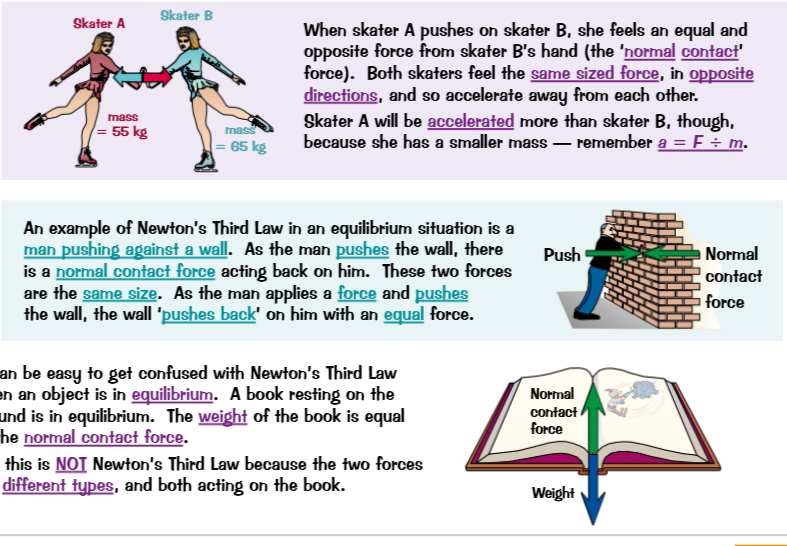
Investigate how mass & force affect acceleration (F=ma, Netwons 2nd law), investigate effect of mass, investigate effect of force
Set up apparatus. Set up the trolley so it holds a piece of card w a gap in middle that will interrupt the signal on light gate twice. If u measure length of each but of card that will pass through light gate & input this into the software, the light gate can measure the velocity for each bit of card. It can use this to work out the acceleration of the trolley
connect trolley to piece of string that goes over a pulley & is connected on the other side to a hook (that u know the mass of & can add more masses to)
The weight of hook & any masses attached to it will provide the accelerating force, equal to mass of hook (m) x acceleration due to gravity (g)
the weight of hook & masses accelerates both the trolley & masses, so u r investigating the acceleration of the system (trolley & masses tgther)
Mark a starting line on table the trolley is on, so that the trolley always travels same distance to light gate
Place trolley on starting line holding it so string is taut (not loose & touching table), & release it
Record acceleration measured by light gate as trolley passes through it. This is the acceleration of the whole system
repeat this twice more to get an average acceleration
To investigate the effect of mass, add masses to trolley one at a time to increase mass of system. Don’t add masses to hook or u’ll change the force. Record the average acceleration for each mass
To investigate effect of force u need to keep total mass of system the same but change the mass on hook. Start w all masses loaded onto trolley & transfer masses to hook one at a time, to increase the accelerating force (weight of hanging masses). The mass of system stays the same as u’re only transferring masses from one part of system (trolley) to another (hook). Record the average acceleration for each force
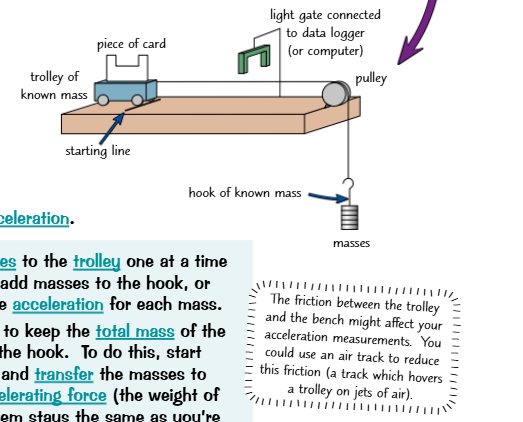
Investigation of newtons second law can be explained by the equation
F=ma
F → weight of hanging masses
m → mass of whole system
a → acceleration of system
By adding masses to trolley, the mass of whole system increases, but force applied to system stays the same. This should lead to decrease in acceleration of trolley as a=F/m
By transferring masses to hook, u r increasing accelerating force w/out changing the mass of whole system. So increasing the force should lead to an increase in acceleration of trolley
In an emergency a driver…, equation for stopping distance, whats thinking distance, whats braking distance, what r typical braking distances (3)
In emergency a driver may perform an emergency stop. This is where maximum force is applied by the brakes in order to stop car in shortest possible distance. The longer it takes to perform an emergency stop the higher the risk of crashing into whatevers in front
stopping distance= thinking distance + braking distance
thinking distance → how far car travels during drivers reaction time (time between driver seeing hazard & applying the brakes)
braking distance → distance taken to stop under braking force (once brakes r applied)
typical braking distances r 14m at 30mph, 55m at 60mph, 75m at 70mph
whats think speed affected by (2)
ur speed - the faster u’re going the further u’ll travel during the time u take to react
ur reaction time - the longer ur reaction time, the longer ur thinking distance
What is braking distance affected by (4)
ur speed - for a given braking force, the faster a vehicle travels, the longer it takes to stop
The weather/ road surface - if its wet/icy, or there r leaves/oil on road, there is less grip (& so less friction) between a vehicle’s tyres & road, which can cause tyres to skid
The condition of ur tyres - if tyres of a vehicle r bald (they don’t have any tread left) then they cannot get rid of water in wet conditions. This leads to them skidding on top of the water
How good ur brakes r - if brakes r worn/faulty, they won’t be able to apply as much force as well-maintained brakes, which could be dangerous when u need to brake hard
need to be able to describe factors affecting stopping distance & how this affects safety. I.e…., speed limits r important because…
need to be able to describe factors affecting stopping distance & how this affects safety - especially in an emergency. E.e. icy conditions increase chance of skidding (& so increase stopping distance) so driving too close to other cars in icy conditions is unsafe. The longer ur stopping distance, the more space u need to leave in front in order to stop safely
Speed limits r really important because speed affects the stopping distance so much
when the brake pedal is pushed…, the faster a vehicle is going.. & this means.., larger brake force means… & very large decelerations can…,
when brake pedal is pushed, causes brake pads to be pressed onto wheels. This contact causes friction, which causes work to be done. The work done between the brakes & wheels transfer energy from kinetic energy stores if the wheels to thermal energy stores of brakes. The brakes increase in temp
The faster a vehicle is going, the more energy it has in its kinetic store, so the more work needs to be done to stop it. This means that a greater braking force is needed to make it stop within a certain distance
A larger braking force means a larger deceleration. Very large decelerations can be dangerous because they may cause brakes to overheat (so they dont work as well) or could cause the vehicle to skid
how can u estimate the forces involved in accelerations of vehicles using typical values
assume deceleration is uniform & rearrange v²-u²=2as to find deceleration
then use F=ma, with m=~1000kg

everyones reaction time… & typical reaction time is…, what can affect reaction time
everyones reaction time is different, but s typical reaction time is between 0.2 & 0.9s
This can be affected by tiredness, drugs, alcohol. Distractions can also affect ur ability to react
how can u measure reaction time w ruler drop test
sit with ur arm resting on the edge of a table (should stop u moving ur arm up/down during the test). Get someone else to hold a ruler so it hangs between ur thumb & forefinger, lined up w 0. U may need a third person to be at eye level w the ruler to check its lined up
without giving any warning, the person holding the ruler should drop it. Close ur thumb & finger to try to catch the ruler as quickly as possible
The measurement on the ruler at the point where its caught is how far the ruler dropped in the time it takes u to react
the longer the distances, the longer the reaction time
u can calculate how long the ruler falls for (the reaction time) because acceleration due to gravity is constant (roughly 9.8 m/s²)
Its pretty hard to do this experiment accurately so u should do a lot of repeats & calculate an average reaction time. The results will be better if the ruler falls straight down - u might want to add a blob of modelling clay to the bottom to stop it from waving about
Make sure its a fair test - use the same ruler for each repeat, & have same person dropping it
u could try to investigate some factors affecting reaction time, e.g. u could introduce distractions by having some music playing or by having someone talk to u while the test takes place
Remember to still do lots of repeats & calculate the mean reaction time w distractions, which u can compare to the mean reaction time w/out distractions
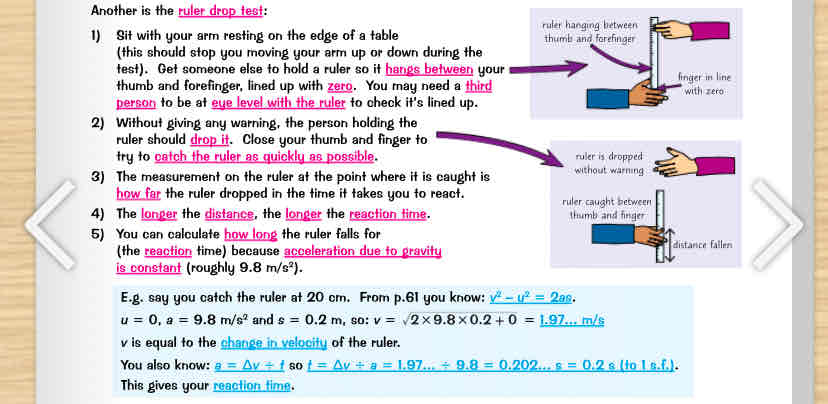
Whats the typical stopping distances (3), to avoid an accident…, speed limits r really important…
To avoid an accident, drivers need to leave enough space between their car & the one in front so that if they had to stop suddenly they would have time to do so safely. ‘enough space’ means the stopping distance for whatever speed they’re going at
Speed limits r really important because speed affects the stopping distance so much

as car speeds up…, this is because…, braking distance however increases… & So as speed doubles…, stopping distance is…,
as car speeds up, the thinking distance increases at the same rate as speed. The graph is linear (straight line)
This is because the thinking time stays pretty constant - but the higher the speed, the more distance u cover in the same time
Braking distance, however, increases faster the more u speed up. The work done to stop the car is equal to energy in the cars kinetic energy store (1/2mv²). So as speed doubles, the kinetic energy increases 4-fold (2²), & so the work done to stop the car increases 4-fold. Since W=Fs & the braking force is constant, the braking distance increases 4-fold.
Stopping distance is a combination of these 2 distances.

…
…

whats momentum, greater mass/velocity of object…, its a _ quantity…, whats the equation
momentum → how much ‘oomph’ an object has. Its a property that all moving objects have
greater mass of object/ greater its velocity, the more momentum object has
momentum is a vector quantity - has size & direction
P=mv momentum (kg m/s) = mass(kg) x velocity (m/s)
whats conservation of momentum, snooker ball example, moving car example, if momentum before an event is 0… & E.g…
conservation of momentum → in closed system, the total momentum before an event is same ws after the event
In snooker, balls of same size & mass collide w each other. Each collision is an event where momentum of each ball changes, but overall momentum stays same (momentum is conserved). The red ball is stationary, so it has 0 momentum. The white ball is moving w a velocity v, so has momentum of p=mv. The white ball hits red ball, causing it to move. The red ball now has momentum. The white ball continues moving, but at a much smaller velocity (& so much smaller momentum). The combined momentum of red & white ball is equal to og momentum of white ball, mv.
A moving car hits into back of parked car. The crash causes 2 cars to lock tgther, & they continue moving in direction that og moving car was travelling, but at lower velocity. Before → the momentum was equal to mass of moving car X its velocity. After → The mass of moving objects has increased, but its momentum is equal to momentum before the collision. So an increase in mass causes decrease in velocity
if momentum before an event is 0, then momentum after will be 0. E.g. in explosion, the momentum before is 0. After explosion, pieces fly off in diff directions directions, so that total momentum cancels out to 0
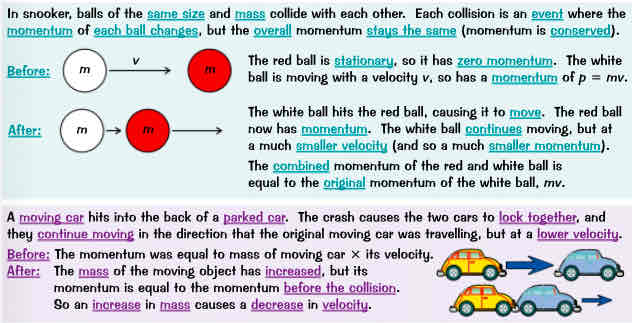
how can conservation of momentum be used to calculate velocities/masses
Calculate momentum of pellet
The momentum before gun is fired is 0. This is equal to total momentum after collision
The momentum of gun id 1.5 x v
Rearrange equation to find velocity of gun. The minus sign shows the gun is travelling in opposite directions direction to bullet
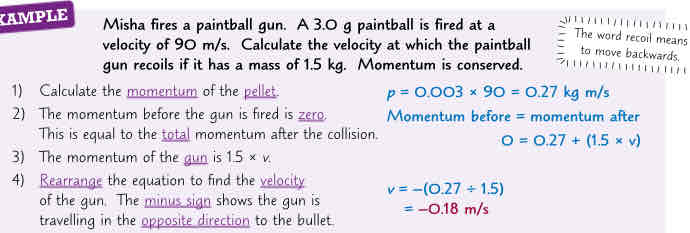
whats change in momentum, know that…, whats equation for force (momentum, time), force causing change is…, larger force means…, if someones momentum changes v quickly.., this is why cars r designed…
change in momentum → when non-0 resultant force acts on moving object (or object that can move), it causes its velocity to change
u know that F=ma & a=change in velocity/ change in time
F=m x v-u/t Or F=m△v/△t
F → Force (N)
m△v → change in momentum (kg m/s)
△t → change in time (s)
force causing the change is equal to rate of change of momentum
A larger force means faster change of momentum
if someones momentum changes very quickly (like in car crash) the force on body will be v large & more likely to cause injury
This is why cars r designed to slow ppl down over longer time when they have crash - the longer it takes for change in momentum, the smaller the rate of change of momentum, & so smaller the force. Smaller forces means faster change injuries r likely to be less severe
3 safety features of cars
crumple zones → crumple on impact, increasing time taken for car to stop
seat belts stretch slightly, increasing time taken for wearer to stop
Air bags → inflate before u hit dashboard of car. The compressing air inside it slows u down more gradually than if u had just hit the hard dashboard
safety features of bike helmets, crash mats & cushioned playground flooring
bike helmets contain crushable layer of foam which helps to lengthen the time taken for ur head to stop in crash. This reduces the impact on ur brain
Crash mats & cushioned playground flooring increase the time taken for u to stop if u fall on them. This is because they r made from soft, compressible (squishable) materials